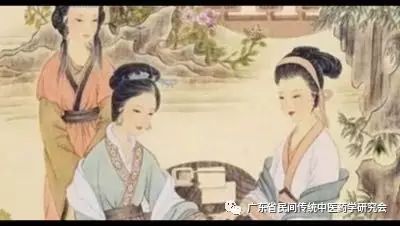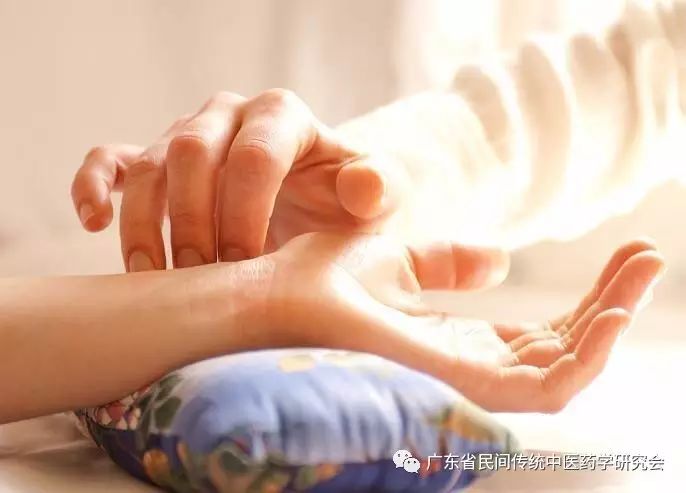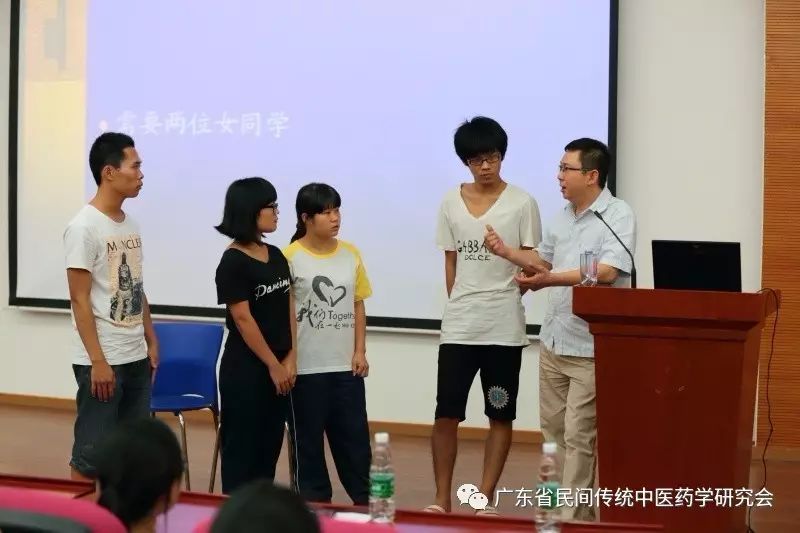
Previously, we discussed the characteristics and treatment of the floating pulse and its related conditions. Today, we will introduce the sinking pulse and its associated conditions. What is the sinking pulse? It is a type of pulse characterized by a low position, where it is not felt with light pressure but can be felt with heavier pressure. According to the “Pulse Classic”: the sinking pulse is insufficient when lifted, but strong when pressed. The “Essentials of Pulse Theory” states: the sinking pulse is absent with light pressure, slightly present with moderate pressure, and strong with heavy pressure, resembling a stone sinking in water. The characteristics include no response to light pressure, a slight response to moderate pressure, and a clear response only when pressing deeply to the bones. The “Pulse Classic” mentions that the sinking pulse requires heavy pressure to reach the bones. It is like sand wrapped in silk, hard inside and soft outside; like a stone thrown into water, it must reach the bottom. The sinking pulse symbolizes a deep spring below. In hexagrams, it corresponds to Kan (坎), in seasons to winter, in humans to the kidneys, also referred to as stone, and also as nourishment. If excessive, it feels like a bouncing stone, becoming firmer upon pressure, indicating an external disease; if insufficient, the qi feels weak and disappears like a number, indicating an internal disease. The “Pulse Classic” states: a slow pulse at the three positions, resembling rotten silk, is not the case. The sinking pulse can be slow and weak, and if it resembles rotten silk, it indicates a weak pulse, not a sinking pulse.

The “Four Examinations” states that the sinking pulse runs between the muscles and bones, requiring heavy pressure to obtain. When pressing down, there is a strong response, but lifting the finger shows a weak response. This pulse resembles a stone thrown into water, inevitably sinking to the bottom, similar to the feeling of touching a stone at the bottom of the water. At the same time, it feels like sand wrapped in silk, soft and smooth on the outside, but hard when pressed inside. The pulses felt in the skin and hair are floating pulses, while those felt in the blood and muscles are sinking pulses.
Sinking Pulse Associated Conditions::The sinking pulse indicates internal conditions. When pathogenic factors are trapped internally, qi and blood become constrained, resulting in a strong sinking pulse, indicating an internal excess condition. If the organs are weak and qi and blood are insufficient, the pulse is sinking and weak, indicating an internal deficiency condition.
Distinction: The sinking pulse must be distinguished from the similar submerged pulse. Both the sinking and submerged pulses are located deep under the skin and require heavy pressure to feel, but the sinking pulse is closer to the bones, located in the middle of the muscles, with a uniform rhythm, while the submerged pulse requires pushing against the bones to be felt. The sinking pulse and floating pulse are opposite pulse types. Clinically, the sinking pulse often coexists with rapid, slow, slippery, wiry, weak, and moderate pulses.

Sinking Pulse and Associated Conditions and Treatments
The “Three Causes of Extreme Disease and Formula Theory” discusses the sinking pulse corresponding to the Ren pulse, both indicating cold lurking in the yin channels; if corresponding to the Qi pulse, it indicates blood stagnation in the abdominal organs.
The sinking pulse indicates internal diseases, which can manifest as excess conditions, water conditions, cold conditions, asthma, and abdominal masses (lumps in the abdomen). A weak sinking pulse indicates cold and heat diseases, a fine sinking pulse indicates qi deficiency, where the arms cannot be raised, a slippery sinking pulse indicates wind and water, leading to heavy and swollen lower limbs, a tight sinking pulse indicates heat above and cold below, a heavy and straight sinking pulse indicates blood stasis, and a heavy sinking pulse with scattered qualities indicates cold injury to food or abdominal masses. If the pulse is tight and sinking, it indicates a suspended fluid condition; if the pulse is slow and sinking, it indicates cold accumulation; if the pulse is heavy, it indicates heat due to summer heat.
The sinking pulse also indicates qi stagnation in the hypochondriac region, often accompanied by cold hands and feet. The person feels weak, with qi rushing to the heart, feeling oppressed but not painful, indicating a deficiency condition. It is advisable to use the Jianwei Lizhong Decoction (建胃理中汤) or the Jianzhong Decoction (建中汤). If the hands and feet are cold, use the Eight Treasure Decoction (八物汤) (Dang Gui (当归), Bai Zhu (白术), Ren Shen (人参), Fu Zi (附子), Bai Shao (白芍), Gui Zhi (桂枝), Ding Xiang (丁香)).
The inch pulse sinking indicates phlegm in the chest; if the pulse is rough and sinking, it indicates obstruction in the chest, turning into phlegm accumulation, which is often treated with the Huatan Yuhujiao Pill (化痰玉壶丸) and Ban Xia Pill (半夏丸).

The fine sinking pulse indicates internal diseases, with the sinking pulse indicating cold, ice, and water diseases. A sinking pulse at the right inch position indicates shortness of breath in the chest, with cold fluids. Chest and hypochondriac pain with water qi, a tight sinking pulse indicates qi counterflow and cold. A fine sinking pulse indicates yin within yang diseases, where the person feels sad, unhappy, and does not like to talk, with little qi and spontaneous sweating, and arms cannot be raised.
The sinking pulse at the left guan position indicates pain below the heart, with shortness of breath and fullness in the hypochondriac region, and cold hands and feet. If the pulse is sinking with a wiry quality, it indicates abdominal pain.
The sinking pulse at the left chi position indicates cold, ice, and back pain, with frequent and concentrated urination, and urine color resembling rice wash. If the pulse is fine, it indicates deep yin conditions, with lumbar issues and inability to stand for long, with dampness and itching below.
The sinking pulse at the right inch position indicates a tight and slippery pulse, indicating cough. If the pulse is fine and slippery, it indicates bone steaming and heat diseases with alternating cold and heat, with dry skin and hair. A fine sinking pulse indicates little qi, and the arms cannot be raised.
The sinking pulse at the right guan position indicates fullness and bitterness in the mouth, with acid regurgitation. A tight sinking pulse indicates suspended fluid, while a sinking pulse below indicates an excess condition.
The sinking pulse at the right chi position indicates water diseases, with heavy and weak lower back and legs. A tight sinking pulse indicates cold pain in the lower back and legs. A fine sinking pulse may indicate severe dysentery. A slippery sinking pulse indicates heaviness in the lower limbs, with the kidneys governing water, which is in harmony with the kidneys.
The large pulse trend with a weak sinking pulse indicates cold and heat, a slow sinking pulse indicates chronic cold, a heavy sinking pulse indicates heat due to summer heat, a tight sinking pulse indicates heat above and cold below, and a heavy sinking pulse with scattered qualities indicates cold food causing phlegm, while a heavy and straight sinking pulse indicates blood stasis in the abdomen.

Simple Summary:
1. Sinking pulse in the heart region: indicates urinary issues, hemoptysis, and nocturnal heart pain, with urinary obstruction.
2. Sinking pulse in the liver and gallbladder region: indicates anger harming the liver, fullness and pain in the hypochondriac region, yellowing of the eyes, abdominal pain, and fullness.
3. Sinking pulse in the spleen and stomach region: indicates stomach fullness, lack of appetite, vomiting, diarrhea, and poor spirit with excessive sleepiness.
4. Sinking pulse in the lung region: indicates cough, shortness of breath, and phlegm with blood loss.
5. Sinking pulse in the kidney region: indicates qi stagnation, low back pain, urinary obstruction, and abdominal pain.
The article is not finished! Please indicate the source when reprinting, and add the author’s WeChat: gzlichanghai to obtain more TCM articles. Contact email:[email protected]
Author’s Biography

Welcome to follow the Research Association’s WeChat public account
The purpose of our association is:
To strictly adhere to the constitution, laws, regulations, national policies, and social morals, to play a guiding, service, self-discipline, rights protection, coordination, and supervision role in the industry, to unite and organize TCM practitioners, especially folk and private TCM personnel and institutions, to maintain and promote the characteristics and advantages of Chinese TCM, to explore, organize, verify, innovate, and promote folk TCM, to enrich and develop TCM studies, to promote academic exchanges in the TCM community, and to contribute to the health of the people and the establishment of a healthcare system with TCM characteristics.
Office address: Room 508, Meijia Plaza, Huangqi Town, Nanhai District, Foshan City, Guangdong Province. Contact number: 0757-81000331

More exciting content, stay tuned!

